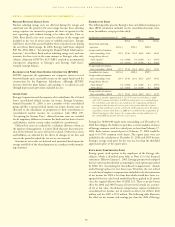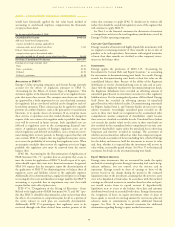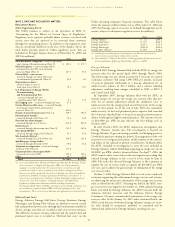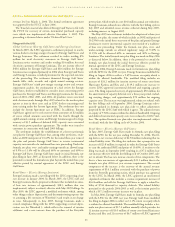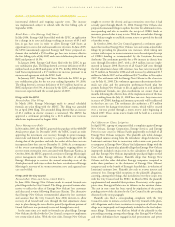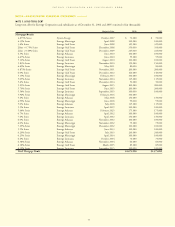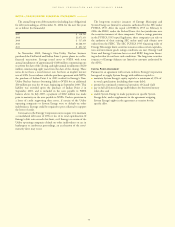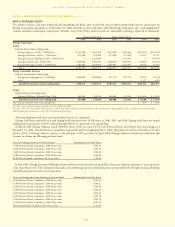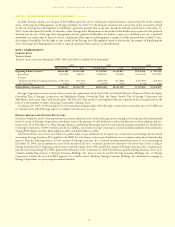Entergy 2006 Annual Report Download - page 84
Download and view the complete annual report
Please find page 84 of the 2006 Entergy annual report below. You can navigate through the pages in the report by either clicking on the pages listed below, or by using the keyword search tool below to find specific information within the annual report.
ENTERGY CORPORATION AND SUBSIDIARIES 2
2000066
68
purchasing practices and included costs in Entergy New Orleans’ fuel
adjustment that could have resulted in Entergy New Orleans
customers being overcharged by more than $100 million over a period
of years. Hearings were held in February and March 2002. In
February 2004, the City Council approved a resolution that resulted
in a refund to customers of $11.3 million, including interest, during
the months of June through September 2004. The resolution con-
cludes, among other things, that the record does not support an
allegation that Entergy New Orleans’ actions or inactions, either alone
or in concert with Entergy or any of its affiliates, constituted a mis-
representation or a suppression of the truth made in order to obtain
an unjust advantage of Entergy New Orleans, or to cause loss, incon-
venience or harm to its ratepayers. Management believes that it has
adequately provided for the liability associated with this proceeding.
The plaintiffs appealed the City Council resolution to the state courts.
On May 26, 2005, the Civil District Court for the Parish of Orleans
affirmed the City Council resolution that resulted in a refund to cus-
tomers of $11.3 million, including interest, during the months of
June through September 2004, finding no support for the plaintiffs’
claim that the refund amount should be higher.
In June 2005, the plaintiffs appealed the Civil District Court decision
to the Louisiana Fourth Circuit Court of Appeal. Subsequent to Entergy
New Orleans’ filing of a bankruptcy petition in the Eastern District of
Louisiana, Entergy New Orleans filed a Notice of Stay with the Court of
Appeal. The Bankruptcy Court lifted the stay with respect to the plain-
tiffs’ appeal of the Civil District Court decision, but the class action
lawsuit remains stayed. In February 2006, Entergy New Orleans filed a
notice removing the class action lawsuit from the Civil District Court to
the U.S. District Court for the Eastern District of Louisiana.
Additionally, in the Entergy New Orleans bankruptcy proceeding, the
named plaintiffs in the Entergy New Orleans fuel adjustment clause law-
suit, together with the named plaintiffs in the Entergy New Orleans rate
of return lawsuit, filed a Complaint for Declaratory Judgment asking the
court to declare that Entergy New Orleans, Entergy Corporation, and
Entergy Services are a single business enterprise, and as such, are liable in
solido with Entergy New Orleans for any claims asserted in the Entergy
New Orleans fuel adjustment clause lawsuit and the Entergy New
Orleans rate of return lawsuit, and alternatively, that the automatic stay
be lifted to permit the movants to pursue the same relief in state court.
The bankruptcy court dismissed the action on April 26, 2006. The mat-
ter was appealed to the U.S. District Court for the Eastern District of
Louisiana, and the district court affirmed the dismissal in October 2006,
but on different grounds, concluding that the lawsuit was premature. In
addition, in April 2006, proofs of claim were filed by
the plaintiffs in the Entergy New Orleans rate of return lawsuit and by
the plaintiffs in the Entergy New Orleans fuel adjustment clause litiga-
tion relating to both the City Council and class action proceedings. The
plaintiffs in the Entergy New Orleans rate of return lawsuit and the
plaintiffs in the Entergy New Orleans fuel adjustment clause litigation
also filed for class certification. In July 2006, the bankruptcy court
denied the request for class certification. The individual claims of the
approximately 14 individual named plaintiffs remain pending in the
bankruptcy proceeding, and it is uncertain whether the bankruptcy
judge will re-open the bar date for other ratepayers to file individual
proofs of claim based on the allegations in the two lawsuits.
ELECTRIC INDUSTRY RESTRUCTURING
Texas
(Entergy Gulf States)
In June 2005, a Texas law was enacted which provides that:
■Entergy Gulf States is authorized by law to proceed with a
jurisdictional separation into two vertically integrated utilities,
one subject solely to the retail jurisdiction of the LPSC and one
subject solely to the retail jurisdiction of the PUCT;
■the portions of all prior PUCT orders requiring Entergy Gulf
States to comply with any provisions of Texas law governing
transition to retail competition are void;
■Entergy Gulf States must file a plan by January 1, 2006,
identifying the power region(s) to be considered for certification
and the steps and schedule to achieve certification (additional
discussion below);
■Entergy Gulf States must file a transition to competition plan no
later than January 1, 2007 (additional discussion below), that
would address how Entergy Gulf States intends to mitigate
market power and achieve full customer choice, including
potential construction of additional transmission facilities,
generation auctions, generation capacity divestiture, reinstatement
of a customer choice pilot project, establishment of a price to
beat, and other measures;
■Entergy Gulf States’ rates are subject to cost-of-service regulation
until retail customer choice is implemented;
■Entergy Gulf States may not file a general base rate case in Texas
before June 30, 2007, with rates effective no earlier than June 30,
2008, but may seek before then the recovery of certain incremental
purchased power capacity costs, adjusted for load growth, not in
excess of five percent of its annual base rate revenues (as discussed
above in “Deferred Fuel Costs,” in December 2005 Entergy Gulf
States implemented a PUCT-approved annual incremental
purchased capacity recovery rider); and
■Entergy Gulf States may recover over a period not to exceed 15
years reasonable and necessary transition to competition costs
incurred before the effective date of the legislation and not
previously recovered, with appropriate carrying charges (as
discussed above in “Filings with the PUCT and Texas Cities,” in
March 2006, Entergy Gulf States implemented PUCT-approved
rates for recovery of its transition to competition costs).
Entergy Gulf States made the January 2006 filing regarding the iden-
tification of power region(s) required by the 2005 legislation, and
based on the statutory requirements for the certification of a qualified
power region (QPR), previous PUCT rulings, and Entergy Gulf
States’ geographical location, Entergy Gulf States identified three
potential power regions:
1. Electric Reliability Council of Texas (ERCOT) as the power region
and Independent Organization (IO);
2. Southwest Power Pool (SPP) as the power region and IO; and
3. the Entergy market as the power region and the Independent
Coordinator of Transmission (ICT) as the IO.
Based on previous rulings of the PUCT, and absent reconsideration
of those rulings, Entergy Gulf States believes that the third alternative,
an ICT operating in Entergy’s market area, is not likely to be a viable
QPR alternative at this time. Accordingly, while noting this alterna-
tive, Entergy Gulf States’ January 2006 filing focused on the first two
alternatives, which were expected to meet the statutory requirements
for certification so long as certain key implementation issues could be
resolved. Entergy Gulf States’ filing enumerated and discussed the
corresponding steps and included a high-level schedule associated
with certifying either of these two power regions.
Entergy Gulf States’ filing did not make a recommendation
between ERCOT and the SPP as a power region. Rather, the filing
discussed the major issues that must be resolved for either of those
alternatives to be implemented. In the case of ERCOT, the major
NOTESto CONSOLIDATED FINANCIAL STATEMENTS continued


